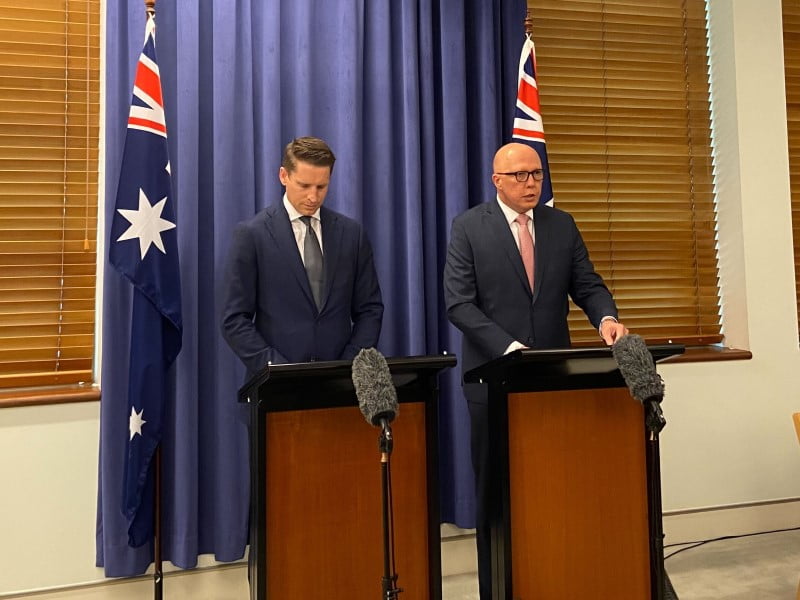Opposition Leader Peter Dutton is calling for more to be done to boost Australia’s STEM skills capacity to deliver the AUKUS pact and that migration will be needed to fill workforce gaps.
After details of the deal were unveiled on Tuesday, Mr Dutton backed the Australian Academy of Science’s warning that “nuclear science in Australia faces a skills crisis [and that Australia is] significantly behind our peer nations in national nuclear and radiation science capability”.
While claiming there has been “very significant effort over state and Commonwealth levels for a number of years in STEM programs”, including during the Coalition’s time in government, he told InnovationAus.com that more needs to be done to ensure Australia can maintain its nuclear submarines and fully benefit from the technology transfers under the second pillar.

“We’re off a zero [nuclear science skills] base here. The United Kingdom has been operating in this space since the 1950s and before that, so there is a lot that we can do domestically and organically. There will be a lot of talent that we’ll need to bring in from overseas, and migration pathways and the rest haven’t been part of the discussion yet,” Mr Dutton said.
“It will be a mature discussion that will need to be had that there will need to be an international workforce that contributes to the success of this program and that will be a good thing because there will be a transferability of skills.
“The training that’s taking place on submarines now and within the US and the UK will quickly build up our skill base and we should be very proud of that.”
Australian Academy of Science president Professor Chennupati Jagadish said in a statement on Tuesday morning that building a nuclear science capability is key to sustaining a nuclear-powered submarine capability and growing demands for “radiotherapies in medicine, focuses on quantum technologies, development of materials robust enough to withstand space radiation”.
“Demand for nuclear scientists to meet existing workforce needs, let alone the national capacity to benefit from new developments in nuclear physics, is running well above supply and the capacity of Australian universities to train sufficient scientists. Australia is overly dependent on overseas trained workforce and lacks the capacity to train new nuclear scientists to meet our existing needs,” he said.
Defence minister Richard Marles and Defence Industry minister Pat Conroy jointly on Tuesday announced the Commonwealth government is developing an AUKUS Submarine Workforce and Industry Strategy which will seek to “embed Australian industry in the UK and US nuclear-powered submarine construction and sustainment programs and supply chains with our partners”.
They also highlighted the Albanese government’s broader ambition to bolster Australian manufacturing “including identifying defence capability as a priority funding area for the $15 billion National Reconstruction Fund.
The strategy will aim to:
- Attract, recruit, develop, qualify and retain a highly-skilled trades, technical, scientific and engineering workforce
- Invest in new infrastructure for sustaining and building nuclear-powered submarines in Australia
- Support and build the capabilities of Australia’s world-leading defence industry
This includes supporting “an existing cohort of over 50 Australians to commence new specialised courses in the UK and US and new tertiary courses for nuclear engineering at the University of New South Wales and nuclear science at the Australian National University”, according to a government statement.
The tranche of AUKUS that will see Australia build a nuclear-propelled submarine fleet of 11 vessels is expected to create around “20,000 direct jobs over the next 30 years across industry, the Australian Defence Force and the Australian Public Service including trades workers, operators, technicians, engineers, scientists, submariners and project managers”.
“At its peak, building and sustaining nuclear-powered submarines in Australia will create up to 8,500 direct jobs in the industrial workforce,” the statement reads. This will include 4,000 Australian workers to design and build submarine construction yard infrastructure in South Australia.
Reiterating Prime Minister Anthony Albanese’s comments that the investment is on par with the creation of the carmaking industry, Mr Conroy described the construction of the submarines as “the greatest industrial undertaking the nation has ever attempted”, surpassing the snowy mountain scheme.
To meet the skills needs to capitalise on the technology transfers of the second pillar of AUKUS, Jennifer Jackett of the University of Sydney’s United States Studies Centre last year called for a trilateral AUKUS visa to allow the three partner nations to “pool, rather than compete for, workers in highly specialised fields”, which some industry representatives have criticised.
Do you know more? Contact James Riley via Email.

